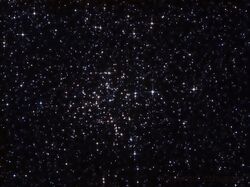Astronomy:Messier 38
| Messier 38 | |
|---|---|
 M38 open cluster | |
| Observation data (J2000.0 epoch) | |
| Constellation | Auriga |
| Right ascension | 05h 28m 43s[1] |
| Declination | +35° 51′ 18″[1] |
| Distance | 3,480 ly (1.066 kpc)[2] |
| Apparent magnitude (V) | 7.4 |
| Apparent dimensions (V) | 21′ |
| Physical characteristics | |
| Radius | 4pc. (13 ly.) |
| Estimated age | 250[2] Myr |
| Other designations | NGC 1912[3] |
Messier 38 or M38, also known as NGC 1912 or Starfish Cluster,[4] is an open cluster of stars in the constellation of Auriga. It was discovered by Giovanni Batista Hodierna before 1654 and independently found by Le Gentil in 1749. The open clusters M36 and M37, also discovered by Hodierna, are often grouped together with M38.[5] Distance is about 1.066 kpc (3,480 ly) away from Earth.[2] The open cluster NGC 1907 lies nearby on the sky, but the two are most likely just experiencing a fly-by, having originated in different parts of the galaxy.[1]
The cluster's brightest stars form a pattern resembling the Greek letter Pi or, according to Webb, an "oblique cross". Walter Scott Houston described its appearance as follows:[6]
Photographs usually show a departure from circularity, a feature quite evident to visual observers. Older reports almost always mention a cross shape, which seems more pronounced with small instruments. A view with a 24-inch reflector on a fine Arizona night showed the cluster as irregular, and the host of stars made fruitless any effort to find a geometrical figure.
At its distance of 1066 pc., its angular diameter of about 20 arc minutes corresponds to about 4.0 parsecs (13 light years), similar to that of its more distant neighbor M37. It is of intermediate age at about 290 million years.[2] From the population of about 100 stars,[7] this open cluster features a prominent yellow giant with the apparent magnitude +7.9 and spectral type G0 as its brightest member. This corresponds to an absolute magnitude of -1.5, or a luminosity of 900 Suns. For comparison, the Sun would appear as a faint magnitude +15.3 star from the distance of M38.
Components
| NAME | Right ascension |
Declination | Spectral Type |
|---|---|---|---|
| HD 35519 | 05h 26m 54.32s | +35° 27' 26.2 | K2 |
| NGC 1912 HOAG 2 | B5II-III | ||
| NGC 1912 HOAG 3 | |||
| NGC 1912 HOAG 4 | 05h 28m 35.39s | +35° 52' 51.2' | A0V |
| NGC 1912 HOAG 5 | 05h 28m 50.73s | +35° 46' 47.2 | A0Vn |
| NGC 1912 HOAG 6 | 05h 28m 10.46s | +35° 55' 26.0 | A0:V |
| NGC 1912 HOAG 7 | 05h 28m 34.25s | +35° 53' 29.7 | A2V |
| NGC 1912 HOAG 11 | |||
| NGC 1912 HOAG 19 | K2IIIb | ||
| NGC 1912 HOAG 104 | G5III | ||
| NGC 1912 SS G2 | |||
| NGC 1912 HOAG 128 | K0III | ||
| NGC 1912 SS G4 | A5:V | ||
| NGC 1912 HOAG 153 | K0V | ||
| NGC 1912 SS G3 | A3V | ||
| NGC 1912 HOAG 160 | K1IV | ||
| NGC 1912 HOAG 161 | G5V | ||
| NGC 1912 HOAG 171 | G7IV | ||
| NGC 1912 HOAG 172 |
See also
References
- ↑ 1.0 1.1 1.2 de Oliveira, M. R.; Fausti, A.; Bica, E.; Dottori, H. (July 2002), "NGC 1912 and NGC 1907: A close encounter between open clusters?", Astronomy and Astrophysics 390: 103–108, doi:10.1051/0004-6361:20020679, Bibcode: 2002A&A...390..103D
- ↑ 2.0 2.1 2.2 2.3 "WEBDA page for open cluster NGC 1912". Department of Theoretical Physics and Astrophysics of the Masaryk University. http://www.univie.ac.at/webda/cgi-bin/ocl_page.cgi?cluster=ngc+1912.
- ↑ "Messier 38". SIMBAD. Centre de données astronomiques de Strasbourg. http://simbad.u-strasbg.fr/simbad/sim-basic?Ident=Messier+38.
- ↑ Carter, J. (2015). March: The Plane Truth. In A Stargazing Program for Beginners (pp. 57-85). Springer, Cham.
- ↑ Majaess, D. J. et al. (2007). "In Search of Possible Associations between Planetary Nebulae and Open Clusters". Publications of the Astronomical Society of the Pacific 119 (862): 1349–1360. doi:10.1086/524414. Bibcode: 2007PASP..119.1349M.
- ↑ Houston, Walter Scott (2005). Deep-Sky Wonders. Sky Publishing Corporation. ISBN 978-1-931559-23-2.
- ↑ "WEBDA page Lynga catalogue data". Department of Theoretical Physics and Astrophysics of the Masaryk University. http://www.univie.ac.at/webda/cgi-bin/frame_list.cgi?ngc1912.
External links
- Messier 38, SEDS Messier pages
- Messier 38 on WikiSky: DSS2, SDSS, GALEX, IRAS, Hydrogen α, X-Ray, Astrophoto, Sky Map, Articles and images
- NASA Astronomy Picture of the Day: Open Star Cluster M38 (7 January 2003)
Coordinates: ![]() 05h 28m 42s, 35° 51′ 18″
05h 28m 42s, 35° 51′ 18″
 |



